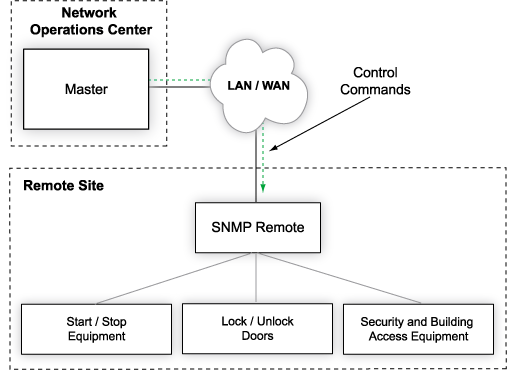Download our free SNMP White Paper. Featuring SNMP Expert Marshall DenHartog.
This guidebook has been created to give you the information you need to successfully implement SNMP-based alarm monitoring in your network.
1-800-693-0351
Have a specific question? Ask our team of expert engineers and get a specific answer!
Sign up for the next DPS Factory Training!

Whether you're new to our equipment or you've used it for years, DPS factory training is the best way to get more from your monitoring.
Reserve Your Seat TodayControlling remote-site equipment from your operations center saves you expensive windshield time, and allows you to respond instantly to on-site problems.
In this application, the system operator can send control commands from your Network Operations Center (NOC) to the on-site SNMP remote. You can even set up certain controls to operate automatically when certain alarm conditions occur.

There are a few different ways to control a device remotely. Most commonly, you'll have a device that has a discrete input for receiving a particular command. This input will be expecting a dry contact closure from your RTU, which is exactly what most RTUs provide.
Imagine, for example, that you have a backup set of beacon lights on an antenna tower. Your monitoring system alerts you that the primary has failed.
Instead of driving out the remote site just to flip on the backup lights (and potentially endangering aircraft and increasing your liability risk for an extended period), you can send a command to your RTU from your desk.
The RTU will latch its control relay, which commands the backup light system's control box to activate the lights. This example can even be fully automated with a smart RTU.
The second type of control is the direct application/removal of power to a device. This generally requires a higher-amperage relay, because most standard RTU relays can support on 1 amp or less.
This kind of remote control is useful when less aggressive control methods won't work. Many servers don't accept a dry contact for power control, and they might not respond if they're "frozen". Cycling power is one way around this problem.
It might seem strange, but some people actually need the reverse application here. Instead of turning SNMP SET commands into relay closures, a relay closure must be converted to an SNMP trap.
There are multiple reasons to do this, but all revolve around legacy compatibility. If you have a fire panel, for example, that is an old "dumb" device that can only understand contact closures.
But what if you have newer gear that legally must (or even just "should") be connected to that fire panel?
You need an intermediary device to connect the two:

Although we didn't foresee that the Trap Relay product would ever be in our future at DPS, we built it because clients like you needed it. Now, it's become quite a popular box.
What do you need DPS to build for you? Call me at 1-800-693-0351 or send me a quick online message.